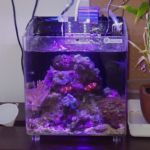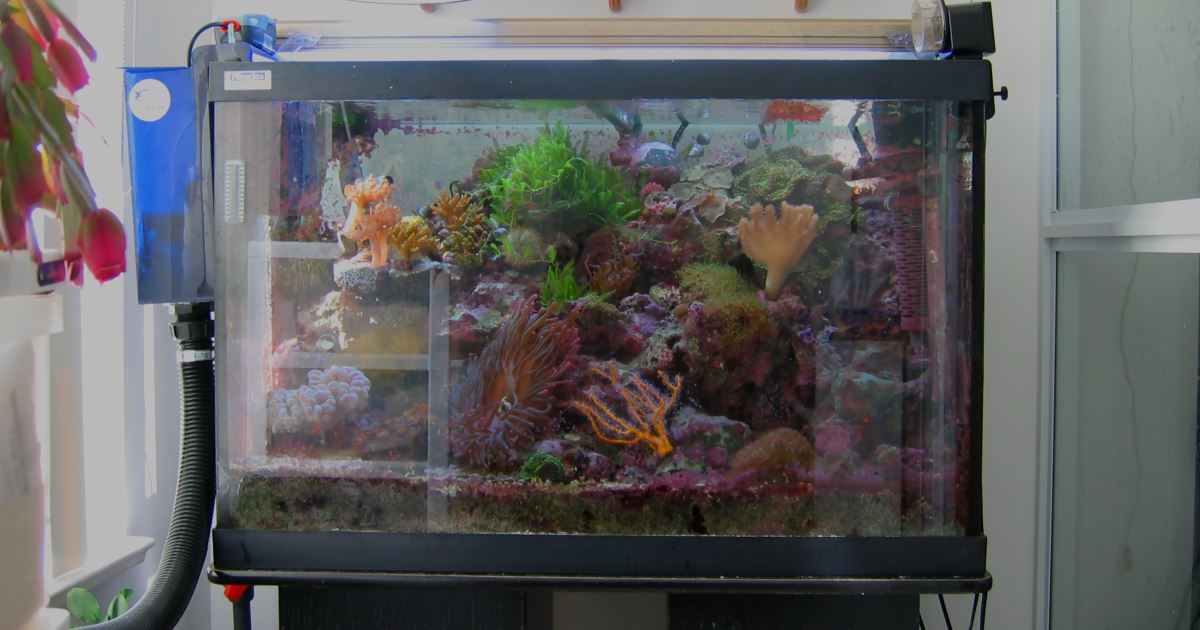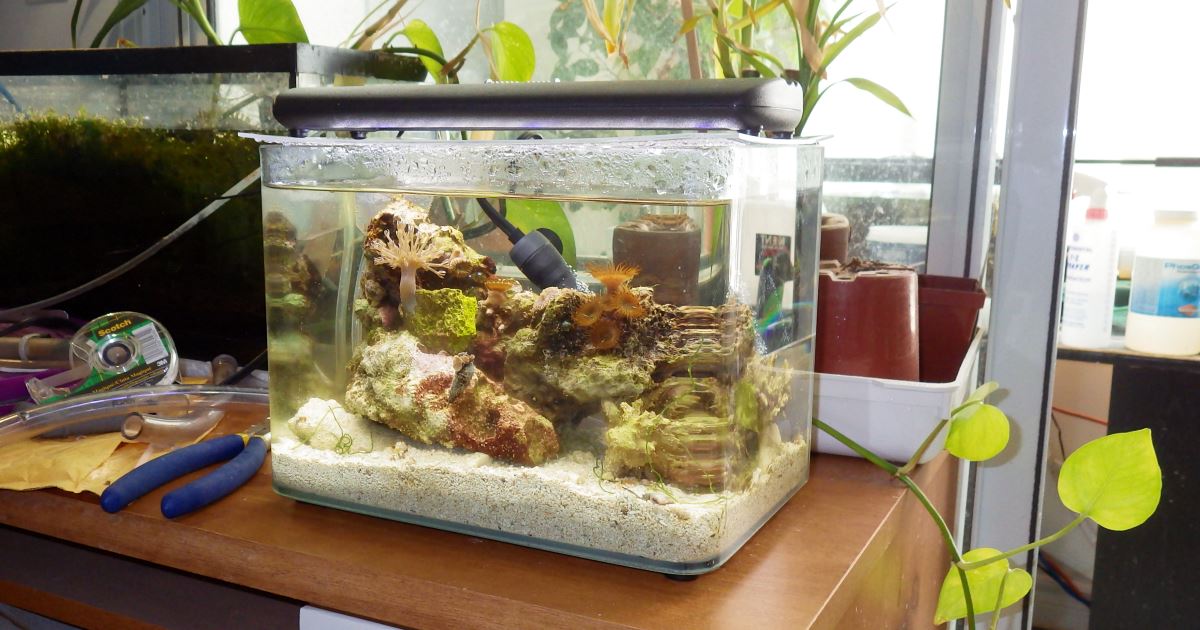I have been in the aquarium hobby since I was a little kid but I have only got involved with salt water after I have moved to Canada.
My very first reef tank in 2003 was a nano. I saw one just like it sitting on the counter in a Big Al’s store and asked the staff how to do it.
Recently I have just downsized my reef tank to a nano again, so it is as good a time as any to reminisce about my journey through the marine aquarium hobby.
It did keep the creatures in it alive (in fact till this day I have some of the Ricordea that was in my first reef tank).
The problems were that I could not get decent lights for something that small, skimmers in that size range were non-existent, and since everything was built into its canopy the tank was fairly closed and the temperature kept climbing (see the computer fan mounted on it, that was for cooling).
So very soon (about 8 month or so after getting my first nano) I have decided to upgrade to a larger tank. Every piece of literature I could find always encouraged people to buy the biggest tank that they can afford. Which sounds good on paper, but I live in a condo apartment.

My first big marine tank setup.
Power heads and internal filters more suitable for a freshwater tank.
The green tubes go to a wet-dry filter under the tank whose main function is to turn all organic waste into nitrates.
The biggest tank that I could possibly pay for would not really fit anywhere, so I have picked up a standard 66 gallon tank with all sorts of inappropriate accessories for a marine tank that various fish store employees thought were good to start with.
Very soon the live rock has cured and I have started stocking the tank.
I kept buying corals etc. to see what lived. It is probably horrible from an environmental point of view, but getting decent information was very difficult. Even books disagreed on how much sand you are supposed to have, or if you even need a protein skimmer.
Very soon I have realized that I needed to change things. First of all I got a sump and because my tank wasn’t drilled (a huge mistake for something that large) I also got a siphon overflow which cost me more than the tank.
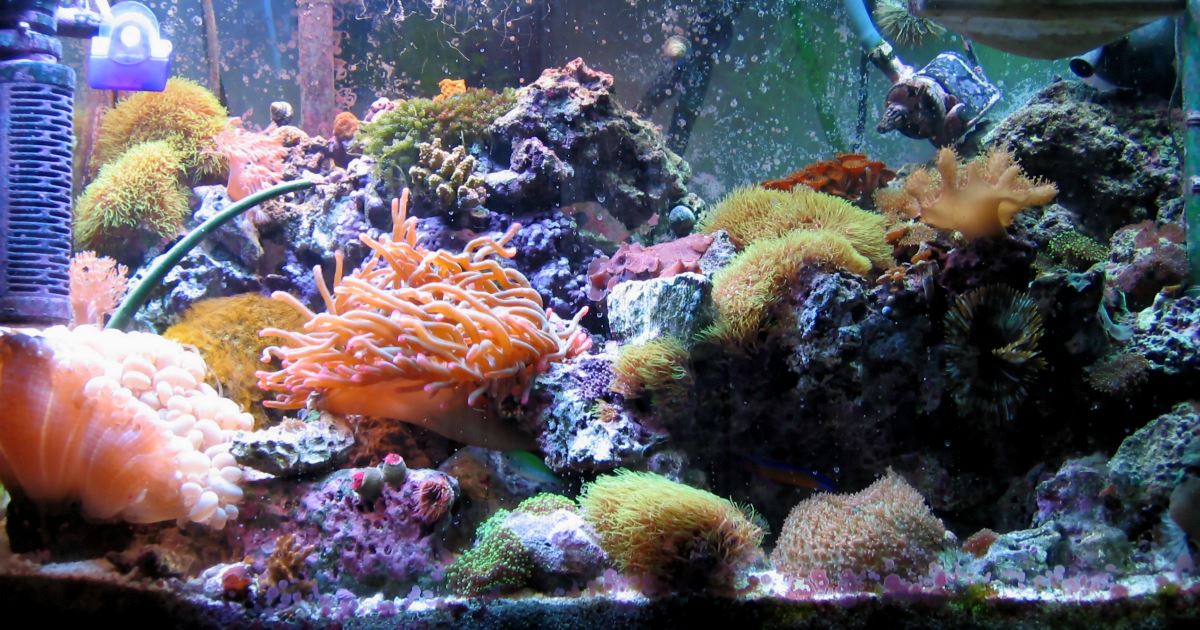
The same tank with a lot of corals crammed into it. They were thriving for a while, but not everything lived.
Also some got too big, and I sold them.
Having a sump allowed me to run a skimmer that wasn’t hanging on the tank and threatening to flood my apartment any minute. Unfortunately I never trusted the siphon overflow 100%, after all if the siphon breaks and the return pump keeps pumping it could still spill a lot of water and cause other kinds of disaster, especially if I am travelling and away for a week — something that all marine aquarists should carefully consider when designing a system.
Unfortunately I was still just learning, so there was very little “design” in spite of my best effort to read up on the subject.
So I have also decided that I really needed advice from fellow marine tank enthusiasts and after some research on the Internet I have joined the Marine Aquarium Society of Toronto.
It was interesting to hear what other people did, on the other hand I did not really see any miracles. It was basically the more money and time you put into it the better your tank is going to get. No clever ways to avoid water changes (in fact it seems like water changes are still a cure for all) and very little enthusiasm about all the small living critters and biodiversity in your tank — everyone is focused on corals and fish with occasional attention to the more colorful invertebrates.
I still had that siphon overflow, and I still had to travel. Out of desperation I have invented a sensor to at least be able to build a device to disconnect the return pump if the tank is about to overflow. Later on I have realized that it also made a good component for an auto top off system, so I could at least build enough machinery to keep the tank running without much human interaction.

Having a sump unfortunately encourages one’s imagination to hook up more and more tanks to it. Apart from my big reef tank very soon a refugium shown on this picture was also plumbed to the same sump. In this picture there is just one mangrove tree, but soon I got a few more and the refugium soon has turned into a mangrove swamp of sorts. It all starts so innocently but before you know it the reef is taking over your entire living space.
I have experimented with various things, such as having a refugium with a real mangrove swamp in it — eventually had to get rid of it when the mangroves grew too big.
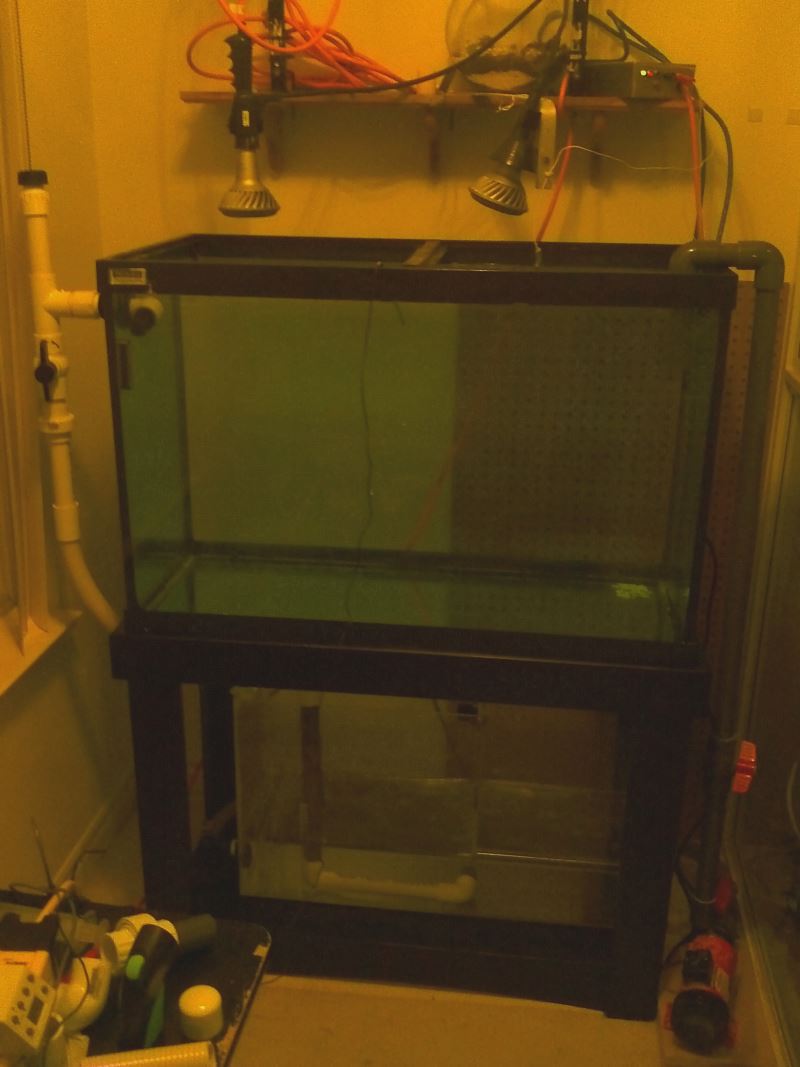
In 2012 I finally had some time, and the tank wasn’t doing too well, so I also had the motivation as well to rebuild a little bit. I have drilled my tank (no more siphon) and arranged it with the sump underneath, like most normal people would do.
Eventually I got a smaller return pump running on DC, a modern skimmer, LED lights, etc. The tank started to thrive, but unfortunately I have not taken any good pictures when it was at its best. Here is a not too good one.
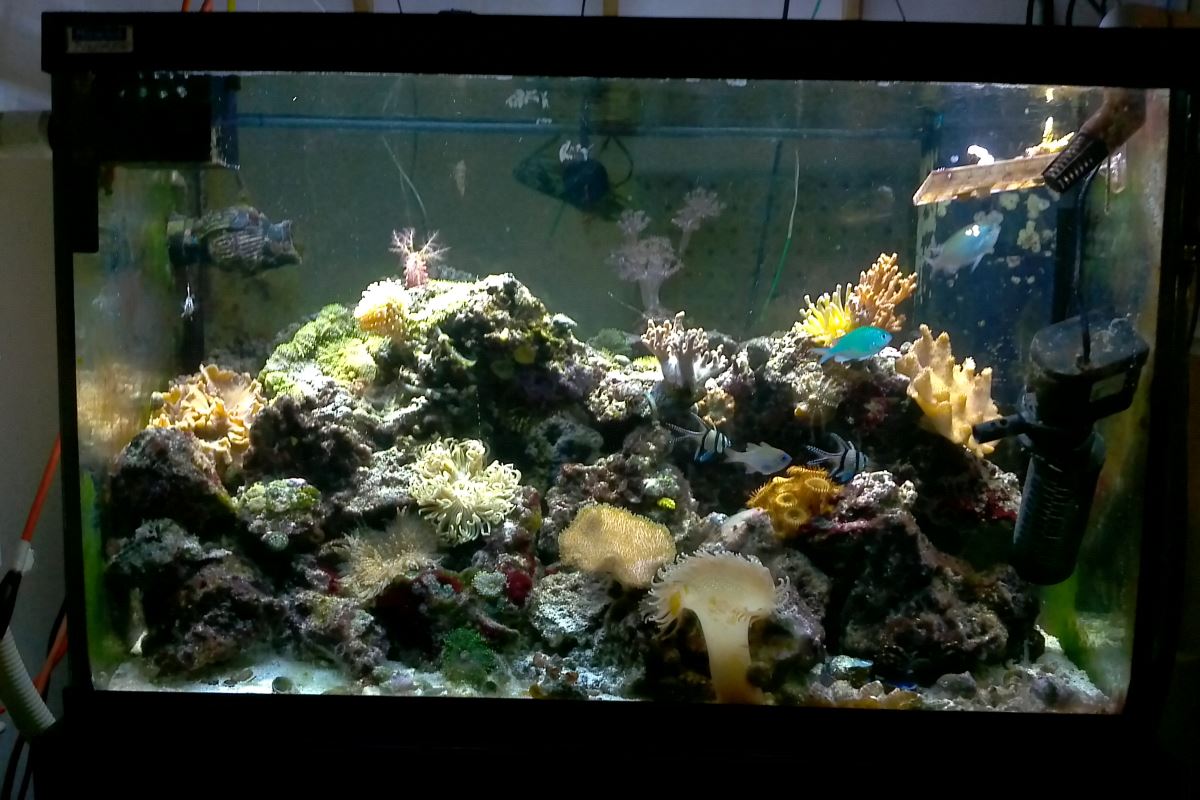
Started to restock the new drilled setup by transferring my existing livestock into it — the corals were camping out in my freshwater tank (in salt water of course) while I drilled the marine one. The leather coral on the right is the same one as I had in my first nano. The anemones were a new addition.
Then in December/2013 disaster struck and the power blackout has wiped out most of the tank when I wasn’t even here.
I have made some effort to restock but my enthusiasm was severely curbed.
Around 2014 I have even started to experiment with pico reefs as an alternative — run a marine aquarium is a gallon or two of salt water.
I have maintained it for about two years (with auto top off it has even survived when I was travelling) but then I have decided that it was just too much trouble and dismantled it, transferring live stock to my big tank.
Yet, my enthusiasm was not restored, I have taken up other hobbies, and my reef tank started to look more like a swamp. So recently I have decided that I am just not going to put in all that work any more that is needed to deal with my big tank, and just get rid of it.
I gave away most of my livestock and live rock and took the tank down.
I did not want to leave the marine aquarium hobby altogether so I have kept some bits and pieces of the rocks and some of the livestock.
The big tank is now replaced by a nano which is in an acrylic tank manufactured by Aqua Excel. It has a powerful needle wheel skimmer appropriate for its size. It also came with a return pump that was just way too strong, noisy, and generates too much heat, so I have replaced it with a smaller pump.
I was able to buy some very bright LED lights appropriate for this size of a tank (by ZETLIGHT) — technology really did advance a lot during the last 15 years.
Since the entire tank has a volume of about 10 gallons or so, doing a water change using a standard 5 gallon bucket means really replacing most of the water with a fresh batch. As everyone seems to think water changes are the solution for everything that ails a marine tank, keeping water changes up should help keep the tank healthy.
I have yet to see how well my new nano does over a longer period of time, but for now it looks good, if I could just control algae bloom that hasn’t subsided completely yet.
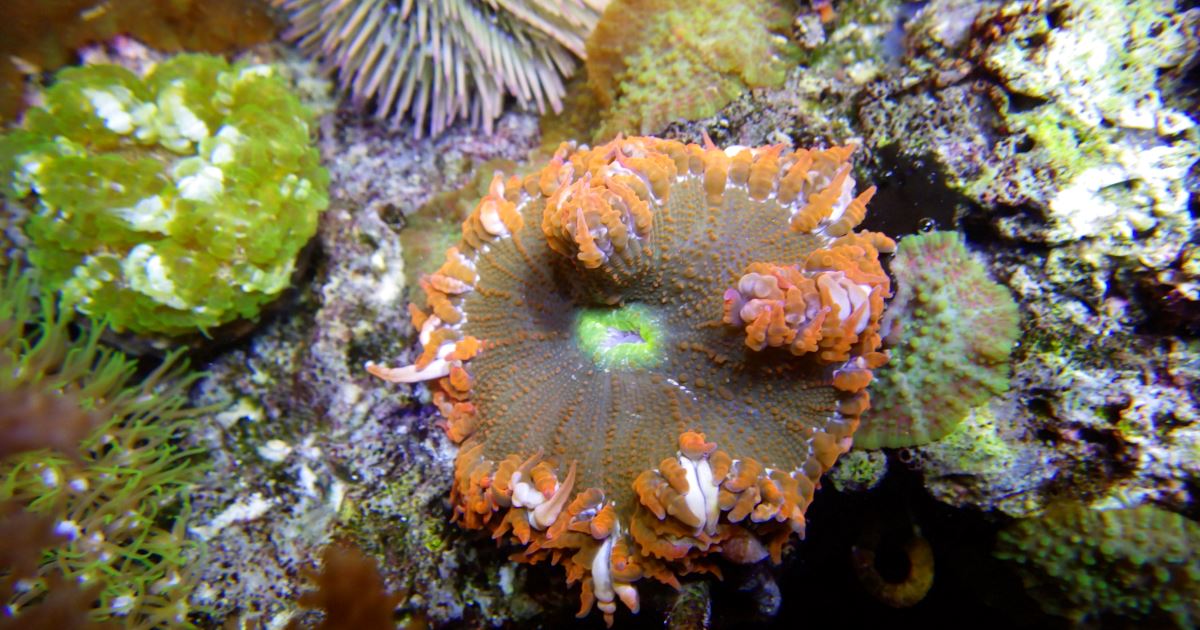
Rockflower anemones. Some of the many creatures that were in my big reef tank in its prime, and get killed by the power blackout of 2013. The beauty of the sea life is a good reason to go into the marine aquarium hobby, but their fragility is a good reason to be cautious. When my reef get wiped up, and I have lost creatures like these anemones that I have just recently acquired along with some that I have had in my tank for more than a decade that was a huge discouragement against staying in the hobby.
When I am writing this post I am still working on building back some biodiversity since the nano tank was set up from what was left over from my big tank after it has lost a lot after the disaster and it has never fully recovered.
It will be interesting to find out if such a small system can be maintained long term without having the ability to fall back to the big one if things start to go wrong.


